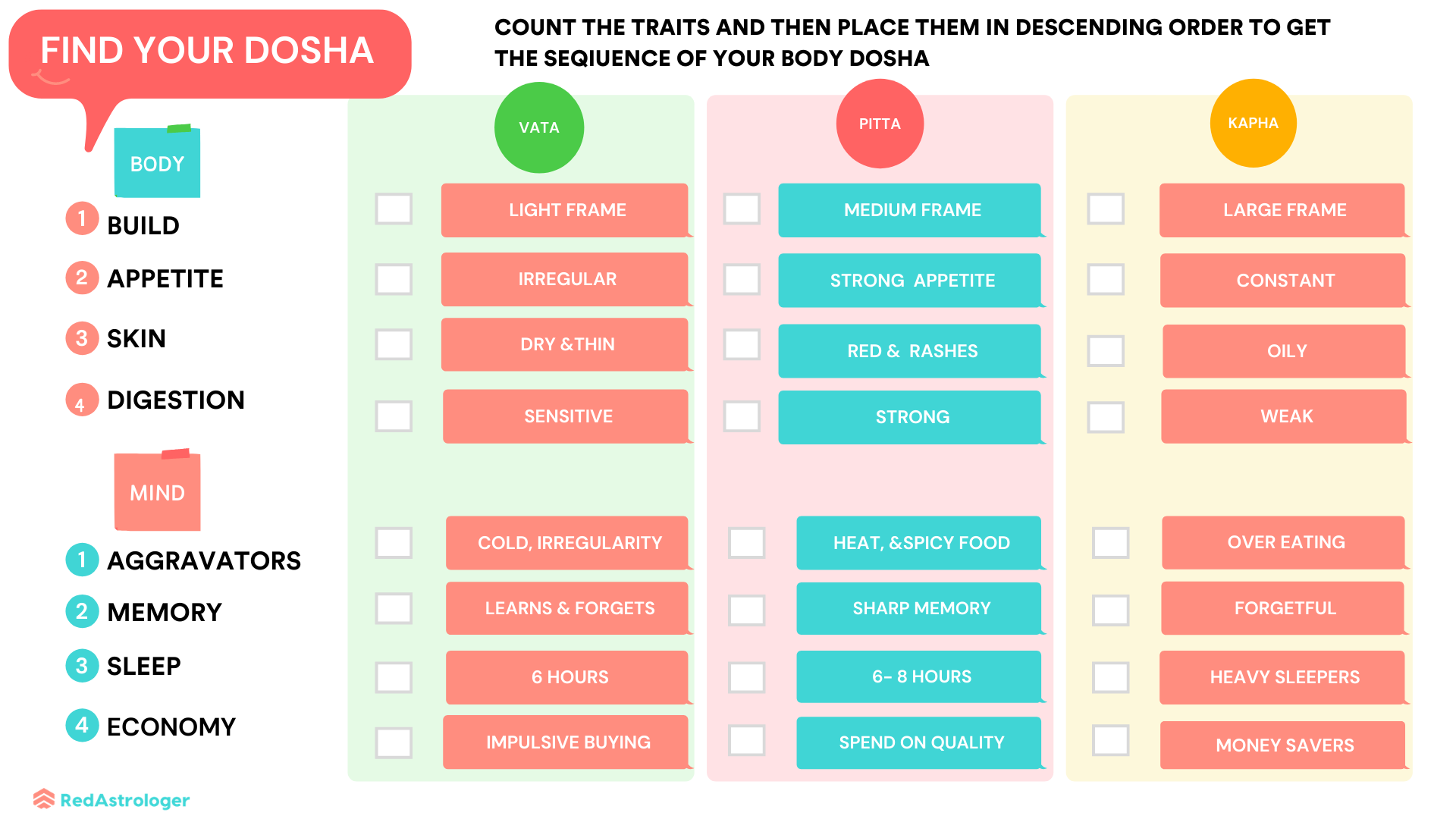Table of Contents
The name “Ayurveda” is derived from two words in Sanskrit, “ayuh” meaning “life” or “longevity” and “Veda” meaning “science” or “sacred knowledge.” Ayurveda’s definition therefore roughly translates as “the science of longevity” or “the sacred knowledge of life.
The purpose of this approach is to bridge a model of physics to a model of physiology through gunas (universal attributes) and karmas (actions). According to Ayurveda mind influences the body, and the body influences the mind.
What is Tridosha?
Each individual is born with a fixed composition of elements mainly Ether, Water, Air, Fire, and Earth. and these elements form three senses of humor in the body known as Vata, Pitta, and Kapha.
Dosha means fault or impurity. Therefore if these doshas are normal in quality and quantity, they maintain harmonious psychophysiology. The moment they go out of balance, they corrupt or pollute the Dhatus (bodily tissues) and then they become dosha. Therefore, dosha is that which becomes impaired and then affects the bodily tissues, leading to disease.
They are the agents of DNA that form the blueprint for physiology. They are energy complexes; these complexes are known by their attributes or gunas.
Energy is required to create movement so that fluids and nutrients get to the cells, enabling the body to function. Energy is also necessary to metabolize the nutrients in the cells and is utilized to lubricate and maintain cellular structure.
Vata is the energy of movement, pitta the energy of transformation digestion, or metabolism, and Kapha the energy of lubrication
and structure.
Every dosha is composed of all five elements. However, two elements are predominant in each.
Vata is Air and Ether.
Pitta is Fire and Water.
Kapha is Water and Earth.
Vāta, pitta, and Kapha are the three Doshas. They support the body when normal and destroy the body when abnormal.
Vata
In the body, Vata is composed of Ether and Air, and this energy is associated with movement. It’s light, cool, and dry in nature and it governs all movement in the mind and body, including blood flow, elimination of wastes, breathing, and the movement of thoughts across the mind. In balance, Vata promotes creativity and flexibility. Out of balance, Vata produces fear, anxiety, and abnormal movements.
Pitta
Pitta dosha is the Ayurvedic mind-body type that is associated with fire and water. It’s sharp and hot in nature and governs metabolism and all heat-related things in the mind and body. Pitta is the dosha of transformation. Pitta is responsible for this “fire” in our bellies, and if it’s out of balance, our entire physiology can be thrown for a loop.
It governs digestion, absorption, assimilation, nutrition, metabolism, body temperature— all transformations. In balance, pitta promotes understanding and intelligence. Out of balance, pitta arouses anger, hatred, jealousy, and inflammatory disorders.
Kapha
Kapha dosha is the Ayurvedic mind-body type that is associated with earth and water. It’s slow and steady in nature and embodies structure and stability in the mind and body. Kapha supplies the water for all bodily parts and systems. It lubricates joints, moisturizes the skin, and maintains immunity. In balance, Kapha is expressed as love, calmness, and forgiveness. Out of balance, it leads to attachment, greed, possessiveness,
and congestive disorders.
Find your Dosha
The (Gunas) Attributes and Doshas
According to Ayurveda, there are twenty basic attributes. Charaka categorized these attributes into 10 opposite pairs (e.g., sharp and slow or dull, dry and oily, liquid, and dense). Ayurveda uses these 20 qualities as a therapeutic guide, a diagnostic tool, and a clinical barometer in order to pinpoint which quality has provoked Vata, pitta, or Kapha.
The 20 Attributes (Gunas)
| Heavy (Guru) | Light (laghu) |
| Slow-Dull (manda) | Sharp (tikshna) |
| Cold (shita) | Hot (ushna) |
| Oily (snigda) | Dry (ruksha) |
| Smooth (shlakshna) | Rough (khara) |
| Dense (sandra) | Liquid (drava) |
| Hard (kathina) | Soft (mrdu) |
| Static (sthira) | Mobile (cala/sara) |
| Subtle (sukshma) | Gross (sthula) |
| Cloudy(avila) | Clear (vishada) |
In Ayurveda, there is a law that states that like increases like. When similar qualities come together, their quantitative expression increases. For example, the summer season has attributes similar to those of pitta— hot, liquid, light, mobile, and penetrating. Therefore, in the summer pitta in the body will be increased.
Vata is light, subtle, dry, mobile, rough, and cold. So, in the fall season, which also exhibits these attributes, Vata will tend to be increased in the human constitution. Kapha is liquid, heavy, cold, sticky, and cloudy. In the winter when these characteristics predominate in the external environment, internal Kapha tends to be increased.
Purush and Prakruti
The Purush is fixed and constant, and Prakriti is variable, Each person’s combination and proportions of Vata, pitta, and Kapha are determined by the genetics, diet, lifestyle, and emotions of the parents, at the time of conception. The combination of the three doshas, which forms the person’s constitution and is set at conception, is called Prakriti.
There are four general categories that describe prakruti Janma prakruti, Deha prakruti, dosha Prakriti, and manas prakruti.
Among these the Janma Prakriti is genetic so it does not change till the end, Deha Prakruti can change through the actions of the mother. And Manas prakruti is subject to change, A person who is born with more rajasic quality can see his manas prakruti change to a predominance of Sattva through meditation, yoga, contemplation, or the guidance of a spiritual master.
Prana, Tejas, and Ojas
In Āyurveda each of the Tridosha and their comprising elements have a fine and subtle essence in addition to the sub doshas referenced above. This essence relates to the more subtle of the two elements that primarily compose each dosha.
- For Kapha dosha and the water element, it is called Ojas.
- For Pitta dosha and the fire element, it is called Tejas.
- For Vāta dosha and the ether element, it is called Prāna.

